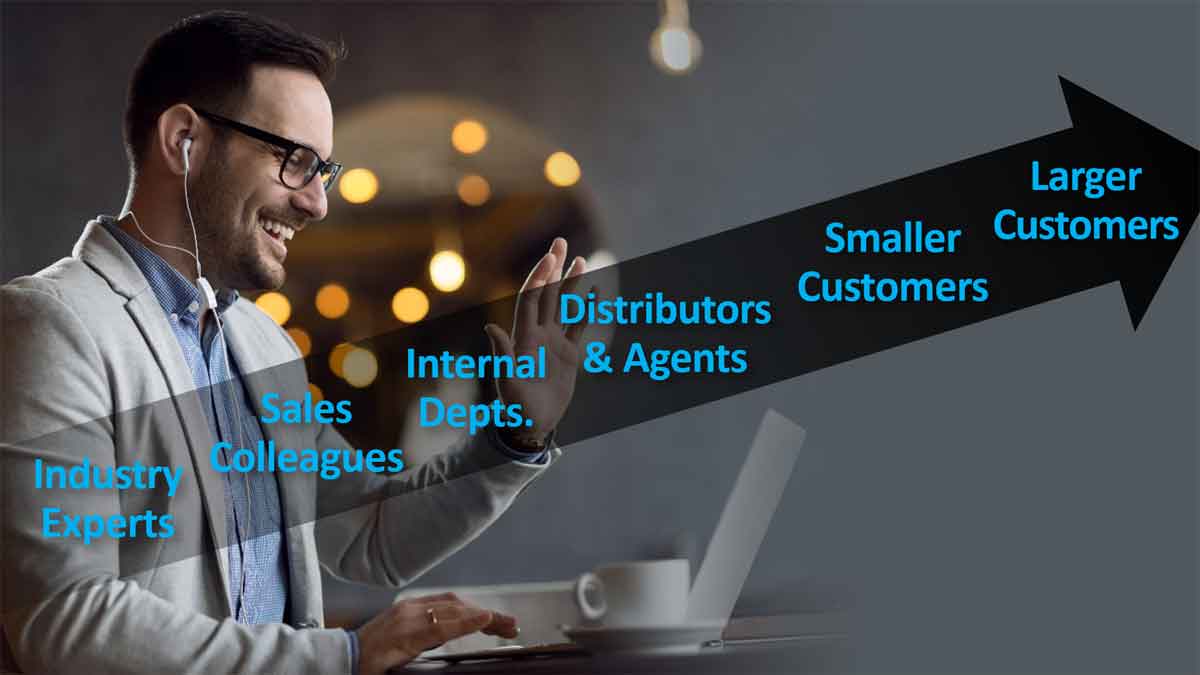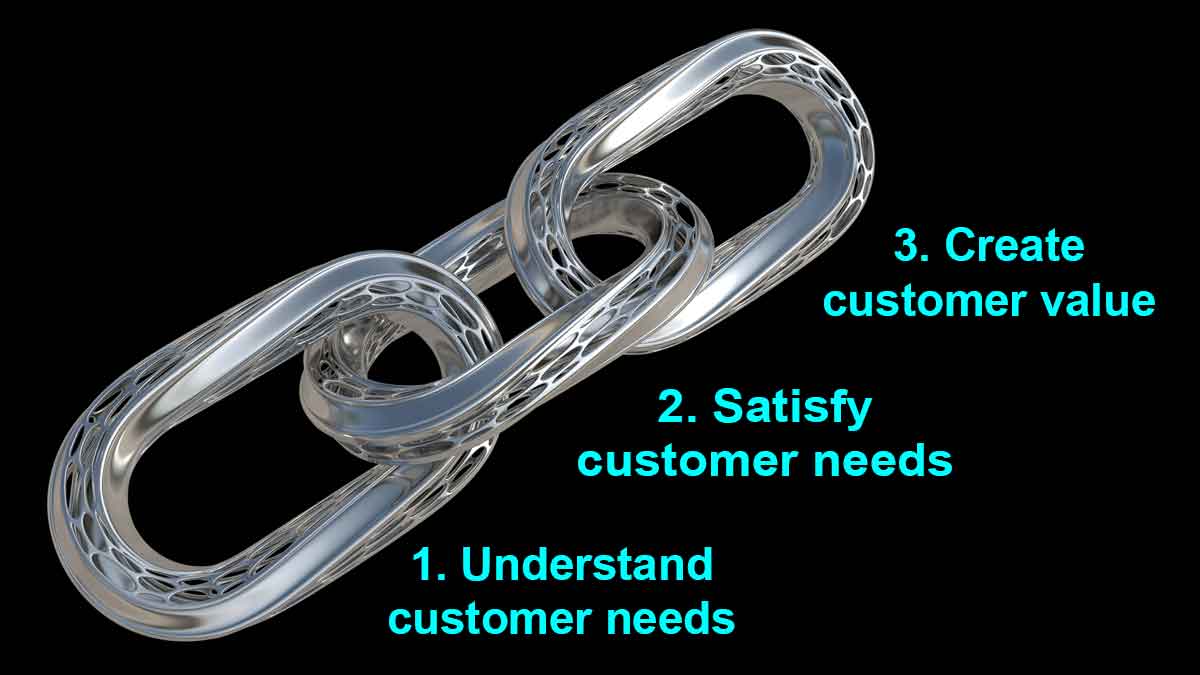Move your organization up through these levels: 1) Conference-roomers: We meet with ourselves to decide what customers want. 2) Expert-askers: We poll our own sales and tech support personnel. 3) Customer-surveyors: We get customer answers… but only to our questions. 4) Qualitative VOC-ers: Our interviews move us from voice-of-ourselves to voice-of-customer. 5) Quantitative VOC-ers: We get unbiased, unfiltered insights. 6) B2B VOC-ers: Our probing takes advantage of powerful B2B advantages.
More in article, The six levels of B2B customer engagement
Want to build an amazing customer interview team in a stress-free manner? Gradually increase the “stakes” of the interview by starting with easier, safer interviews. You might follow this six-step progression: 1) industry experts you pay to interview, 2) sales colleagues, 3) other departments/experts in your company, 4) your distributors, 5) smaller, safer customers, and finally, 6) larger, high-stakes customers. By the time you reach the later group, you’ll have one highly-polished and confident interview team.
More in article, Virtual VOC: 10 Advantages and 7 tips
Why would a company ever want to be a fast follower? I can only think of one reason: They want to reduce commercial risk, by coat-tailing a competitor’s market success. After all, fast-followers don’t reduce technical risk. This only increases, given the need to work around competitive patents. With B2B markets, you can eliminate most commercial risk through B2B-optimized voice-of-customer interviews. (See e-book, Reinventing VOC for B2B.) Turns out the fast-follower strategy is a misguided strategy for B2B.
More in article, Chasing the Fast Follower Myth
While in-person interviews remain the “gold standard,” we’ve found 10 advantages to virtual voice-of-customer. These include 1) lower cost, 2) reaching dispersed customers, 3) viewable probing tips, 4) colleague training, 5) probing suggestions, 6) note-taker assistance, 7) rapid debriefing, 8) easier scheduling, 9) low-impact cancellations, and 10) greater project speed. If you’re not taking advantage of these advantages, you’re forfeiting effectiveness and efficiency in your customer insight efforts.
Download our white paper at www.virtualvoc.com
This is one of the 48—count ‘em—48 laws of Jobs-to-be-done philosophy in Scott Burleson’s book, The Statue in the Stone. Just as Michelangelo “removed everything that wasn’t David,” so successful new-product innovators seek to remove whatever is preventing perfection in the job that customers “hire” their product to improve. Good news for B2B innovators: Customers can tell you exactly what to remove in astonishing detail… where to chisel, where to sand, where to polish… but only if you know how to ask.
More at Dan Adams interviews Scott Burleson about his new book, The Statue in the Stone
Reliable growth boils down to three linked principles. 1) Your company’s only path to profitable, sustainable organic growth is to create customer value. 2) You only create customer value when you satisfy customer needs that were important and unmet. 3) You must first understand customer needs. You cannot efficiently, effectively improve that which you do not fully comprehend. So it’s time to stop thinking about voice-of-customer as just “one more initiative.” It’s much more. It’s the first link in the growth you want.
More in article, Predict the customer’s experience with modeling.
Qualitative customer interviews let you move from ‘guessing’ to ‘understanding’ customer needs. But proper quantitative interviews provide the insight you need to ‘model’ customer needs. This means you can design your new product with confidence… know how to make intelligent tradeoffs… and even understand how customers will react to your product without seeing a prototype. This works only for B2B and will someday be a common practice. But it’s uncommon today… and a profound competitive advantage.
See how in the article, B2B Customer Needs: Predict the customer’s experience with modeling.
Champions in any sport know which muscle groups to build… with balance. A rock climber with great finger strength also needs superb core strength. You have two primary innovation muscle groups… one to understand customer needs and one to meet those needs with your new products. Your B2B business might be spending tens of millions of R&D on the latter muscle group. Keep these “meeting” muscles in shape… but start building your “understanding” muscles. That’s how you get to the top ahead of competitors.
More in article, New Product Training: Time to Build Growth Muscles.
This is how one client described his experience with one of his company’s initiatives. Take understanding customer needs, for example. Many companies discuss and debate this year after year, but the wheels just keep spinning without traction. Nothing worthwhile happens until a) people are trained, b) metrics are established and c) new behaviors are rewarded. As Peter Drucker said, “Plans are only good intentions unless they immediately degenerate into hard work.”
More in article, New Product Training: Time to Build Growth Muscles
Do you clearly distinguish between technology development and product development? Technology development is science-facing, while product development is market-facing. Technology development turns money into knowledge, and product development turns knowledge back into money. Keep technology and product development separate if you want to avoid confusion and inefficiency. Milestones on a Gantt chart are great for product development, but good luck scheduling technical breakthroughs in your lab.
More in article, Timing is Everything (p6).
As explained by Tony Ulwick in What Customers Want, the term customer “needs” can be confusing. It’s best to separate what customers want into outcomes (their desired end-result, or the “what”) and solutions (your answer to their need, or the “how”). Keep your interview focused on their outcomes, not solutions. If they offer a solution, simply ask, “What would that do for you?” Poof: You’re back into outcome space where you want to be.
More in article, Discovery Interview Blunders that Frustrate Your Customers.
In the best B2B interviews, you ask “What other problems do you see?” or “What would your ideal world look like?” The customer leads the interview—not you—because you never know what they’ll say next. But allow some silence: Don’t fill the void by saying, “for example, would it help if…?” Your patience may be rewarded with a customer need you would never have heard otherwise… one that could lead you to develop a blockbuster product. Silence—and the thinking it allows—can indeed be golden.
More in article, Discovery Interview Blunders that Frustrate Your Customers.
When we train B2B professionals to interview their customers, we tell them to be the student and let the customer be the teacher. After all, customers know their world best and love to demonstrate their expertise… so practice humility. Afraid customers will think less of you if you don’t show how smart you are? Sorry, but I’ve got news: They aren’t thinking of you. They’re thinking of themselves and their ideas. So be a brilliant conversationalist. That’s someone who thinks what the other person says is fascinating.
More in article, Discovery Interview Blunders that Frustrate Your Customers.
I’m still looking for the business that failed—or even suffered—from understanding customers too well. Maybe I should stop looking for this rare “black swan” event? It’s certainly no challenge finding companies that don’t understand customer needs well. Sadly, many also don’t understand how badly their lack of customer insight is stunting their growth. Get this right and you may not be a black swan… but you’ll certainly stand out from the rest of the flock.
See video on B2B voice-of-customer at www.vocforb2b.com.













